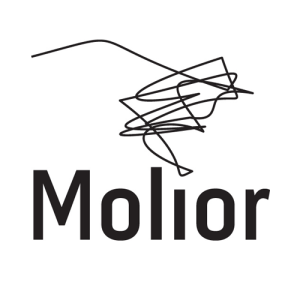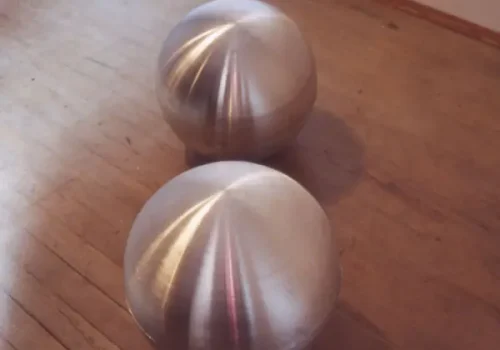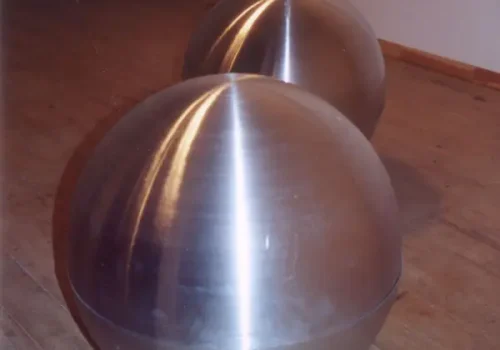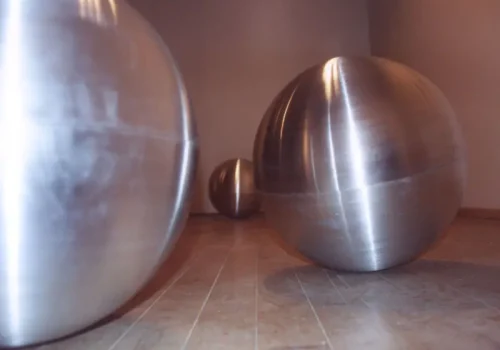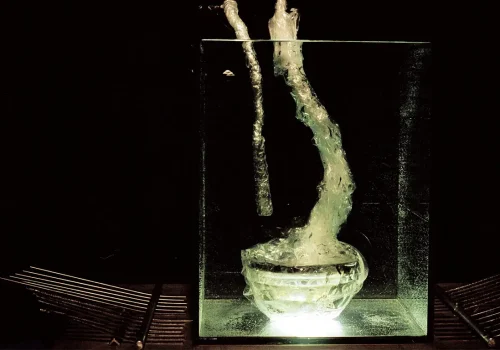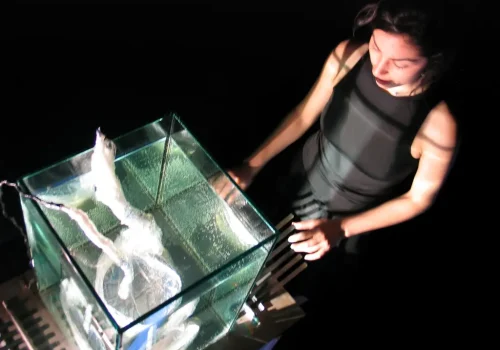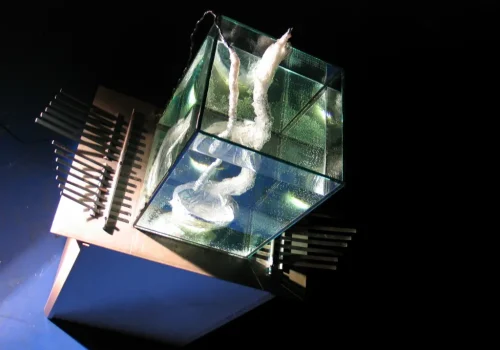FILE 2005
Electronic Language International Festival, São Paulo
From November 1st to November 20th, 2005
For the Second year running Groupe Molior are proud to present the work of Canadian artists in the Electronic Language International Festival -FILE in São Paulo Brazil. This will be the sixth year that FILE has been in operation and presenting the work of international artists and new media professionals.
Andrée Duchaine
Andrée Duchaine has worked in the visual arts area since several years. From 1974 to 1984 she was involved in setting up the video section at Vehicule Art Gallery and organized and curated VIDEO 84, the first international video encounters in Montreal. Mrs Duchaine curated several video art exhibitions in Europe, the United States and Canada. Between 1985 and 1995 she settled in Paris where she founded a short film distribution company. She worked with T.V. channels across the world.
Andrée Duchaine taught at Paris VIII, at the Université du Québec à Montréal and at the Ottawa University. In 2001 she founded a non-profit company Le Groupe Molior producing, curating and disseminating new media works.
Artists & work
Constanza Silva
Silverfish Stream
2005
Interactive installation
Description of the work
Silverfish Stream is a sensual, poetic exploration of the potentials of human-machine interaction. Communicating robotic spheres move through the gallery space, adjusting their behaviors in relation to each other; the result is an awkward and unpredictable pas de deux that both absorbs and excludes the viewer. Within this field of metal and fleshy bodies that adjust and readjust to each other, a complex sound environment emerges. Sonic vibrations from the machines are transformed and modulated by the movements of bodies within the multi-centric system.
Biography
Constanza Silva is a new media artist who creates complex, sound and robotic environments by setting minimal forms in motion within networked, interactive systems. Since 1995, she has integrated performance, video, sound, and electro-mechanical elements to explore embodied experience and agency within natural, technological and political ecologies. The environments she creates are dynamic fields in which the concrete and the incorporeal—metal forms, fleshy bodies, information and sensation—pass into and transform each other.
Silva holds an MFA from Concordia University, Montréal and a BFA from the Emily Carr Institute of Art and Design in Vancouver. Her works have been exhibited in Vancouver, Toronto and Montréal. Over the last decade she has participated in numerous projects, exhibitions and performances, some of which include: Iguana/Iguana Confirmed (2004) Techno experimentations in gallery, DARE-DARE, Montréal; Sin ruido, en memoria (2002), Transito, Marché Bonsecours, Montréal; and Flagrante Delicto (2001), Planet In Focus, the Toronto International Environmental Film and Video Festival. She has received awards from private foundations, the B.C. Arts Council, le Centre interuniversitaire des arts médiatiques, and the Canada Council for the Arts. Silva was born in Colombia and raised in Canada. She is currently working and residing in Montréal.
Martin Leduc
Totem sonique
2005-2006
Interactive sound installation
Description of the work
Totem sonique (Sonic Totem) is an interactive sound installation created by Martin Leduc as part of his Master’s in Interactive Media at l’UQÀM. Totem, designed to be touched and played, invites visitors to explore and experience an innovative sound universe by activating metal strips grouped together into four keyboards around a vertical water-filled glass sounding-box, radiating light and reflections that move with the frequencies. Totem sonique, at once an invented instrument and a sound-processing automaton, is an invitation to the free expression of personal and collective creative potential. The water column houses an underwater broadcasting and receiving system, producing “aquafeedback” that the automaton controls. If undisturbed, the automaton arranges and generates its own compositions. When visitors are present, it modulates the sound matter produced by the play of both visitors and automaton. A human/machine dialogue springs from the encounter, intertwining mutual object-subject influences.
Totem sonique’s user-friendliness and the sound organization born from the exchange allow the focus to remain on play and listening, replacing the traditional paradigm of the performer with one focused on perception and discovery. The automaton enhances the proposed structures and transforms the aesthetic and the space from the shadows. Instantly, the human being no longer triggers the sequence nor activates the sensors, but participates in a physical and intentional communication unfurling in a universe of sound in a constant state of metamorphosis (Martin Leduc, April 2004).
The aesthetic and technological choices behind Totem sonique are unique in that the sound matter is provided exclusively by the play of installation visitors. Nothing is pre-recorded or synth-generated, and the structure provided is flexible and unpredictable. This relational and communicational sound organization fluctuates based on play, manifesting in the mutual influence that the visitors and Totem have on each other.
Biography
An islander during his youth, his ears attuned to the soundscapes provided by night along the water, he found a guitar in a boat and, very early on, began to compose using a variety of tones. For 20 years a Montrealer, Martin Leduc designs unique electro acoustic instruments and creates interactive sound installations in which algorithmic composition is combined with a systemic approach that makes spectators a part of the compositional system. His instruments are sculptures that are to be viewed, heard and modulated through their interaction with the public and the environment.
Totem sonique, his aquatic sound installation, provides a collaborative creative experience that is equipped with a variety of sound capturing devices, including an underwater microphone, that are integrated with the instrument. It is assisted by a sound transformation program that listens to the interactors’ gestures and transforms the sound material in response to it. Totem sonique has been shown in Montréal, at the University of Maine museum in Bangor, in Sao Paolo, Brazil in the framework of the FILE festival, and at the Jardins de Métis in Gaspésie, as an outdoor interactive installation and interactive performance sound sculpture.
An instructor and research assistant at UQAM (CIAM, LMI, GRAMI), his academic career has taken him from the pure sciences to literature via anthropology, resulting in a Bachelor’s in Anthropology, with courses in ethnomusicology. He completed a Master’s in interactive media communications and coursework in electro acoustics in 2006. In 2007, he began an inter-university doctorate in the study and practice of the arts at the Université du Québec à Montréal and in electro acoustics at the Université de Montréal.
